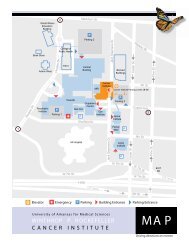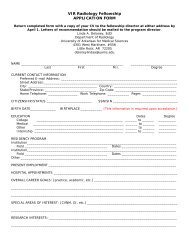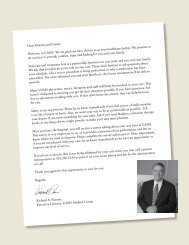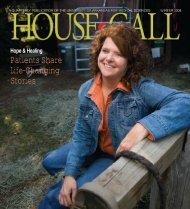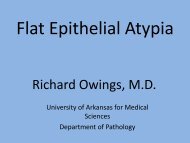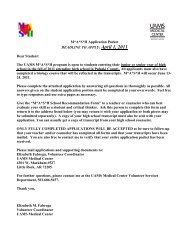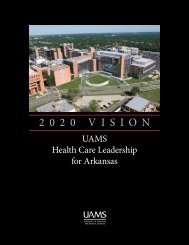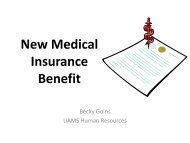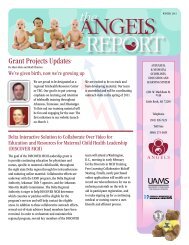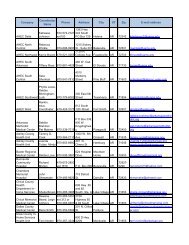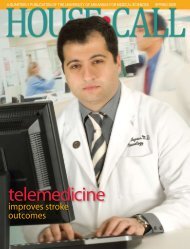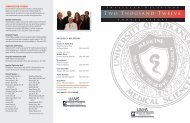Emergency Preparedness - UAMS Medical Center
Emergency Preparedness - UAMS Medical Center
Emergency Preparedness - UAMS Medical Center
Create successful ePaper yourself
Turn your PDF publications into a flip-book with our unique Google optimized e-Paper software.
<strong>Emergency</strong><br />
<strong>Preparedness</strong><br />
• Working as a Team<br />
• Training First Responders
contents<br />
spring 2008<br />
4<br />
6<br />
8<br />
10<br />
Ready for Anything<br />
Whether manmade or natural, <strong>UAMS</strong> has a plan for<br />
whatever emergency may strike.<br />
In the Event of an <strong>Emergency</strong><br />
Allied health professionals play a key role in<br />
emergency preparedness.<br />
Going High Tech<br />
Simulated training gives students an educational<br />
advantage.<br />
On the Lookout<br />
Computerized system keeps health screenings<br />
top of mind.<br />
in every issue<br />
3 The Chancellor’s Corner<br />
14 Did You Know?<br />
p. 4<br />
16 Healers Joy Banks’ grandparents inspired<br />
her work with glaucoma patients.<br />
17 Partners Little Rock dad chairs event for<br />
Arkansas’ tiniest babies.<br />
12<br />
18<br />
19<br />
Forget Me Not<br />
Memory Loss Team advances treatment and<br />
research of dementia.<br />
Renewed Hope<br />
Nationally recognized author turns to <strong>UAMS</strong><br />
for cancer care.<br />
At the Forefront<br />
Arkansas <strong>Center</strong> for Health Improvement<br />
celebrates its 10th anniversary.<br />
On the cover: Ron Crane is emergency<br />
preparedness manager at <strong>UAMS</strong>.<br />
Cover photo by Michael Pirnique.<br />
<br />
HOUSE • CALL
HOUSE•CALL<br />
spring 2008<br />
editor<br />
Susan Van Dusen<br />
art director<br />
Laurie Shell<br />
managing editor<br />
Liz Caldwell<br />
creative director<br />
Keith Runkle<br />
writers<br />
Liz Caldwell<br />
Jon Parham<br />
David Robinson<br />
Susan Van Dusen<br />
photographer<br />
Johnpaul Jones<br />
editorial advisory board<br />
Kathy Alexander<br />
Jerry Atchley<br />
Anne Bynum<br />
Cindy Pugh<br />
Dale Ronnel<br />
Carla Spainhour<br />
Judy Snowden<br />
Becky Tucker<br />
chancellor<br />
Dr. I. Dodd Wilson<br />
vice chancellor of<br />
communications and marketing<br />
Pat Torvestad<br />
associate vice chancellor of<br />
communications and marketing<br />
Leslie Taylor<br />
assistant vice chancellor of<br />
communications and marketing<br />
Tim Irby<br />
HouseCall is published quarterly by the<br />
<strong>UAMS</strong> Office of Communications and Marketing<br />
4301 W. Markham St. #890, Little Rock, AR 72205-7199<br />
Phone: (501) 686-5686 Fax: (501) 686-6020<br />
A Gift to Research<br />
In the true spirit of philanthropy and<br />
compassion, Little Rock’s Tenenbaum family has<br />
established a legacy honoring two exceptional<br />
women, the late Muriel Balsam Kohn and<br />
<strong>UAMS</strong>’ Dr. Suzanne Klimberg.<br />
Just as many families have been touched<br />
by breast cancer, so has the Tenenbaum<br />
family. Muriel Balsam Kohn, mother of Judy<br />
Tenenbaum, fought a courageous battle against<br />
the disease prior to her death in 1993. While<br />
we remember her dedication to family and her<br />
spirit of volunteerism, the Tenenbaum family<br />
has chosen to honor her memory in a unique<br />
and lasting way through the establishment of the<br />
Muriel Balsam Kohn Chair in Breast Surgical<br />
Oncology.<br />
This chair, which is the first endowed<br />
chair in the <strong>UAMS</strong> Department of Surgery,<br />
will provide funds in perpetuity for the work<br />
of breast cancer researchers at <strong>UAMS</strong>. The<br />
inaugural recipient is Dr. Klimberg, chief of the<br />
chancellor’s corner<br />
<strong>UAMS</strong> Division of Breast Surgical<br />
Oncology and director of the<br />
Breast Cancer Program at the<br />
Winthrop P. Rockefeller Cancer<br />
Institute.<br />
Dr. Klimberg and the<br />
Tenenbaum family share both<br />
a longstanding friendship and<br />
a deep conviction that through<br />
advancements in research and<br />
treatment, breast cancer can<br />
be overcome. The Tenenbaum<br />
Foundation, which was created<br />
in 1964 by Harold Tenenbaum’s<br />
father, Joe M. Tenenbaum, has<br />
made breast cancer awareness<br />
and research a funding priority,<br />
particularly as it affects the central<br />
Arkansas community.<br />
Dr. Klimberg is internationally<br />
recognized for her innovative<br />
advancements in breast cancer<br />
treatment, including the use<br />
of radio frequency ablation to<br />
reduce or eliminate the need<br />
for follow-up surgery, reduce<br />
recurrence of breast cancer at<br />
the original site, and even<br />
reduce the need for radiation treatment.<br />
Her research also includes the development<br />
of the Axillary Reverse Mapping procedure, a<br />
technique that Dr. Klimberg created that allows<br />
the surgeon to identify during surgery the way<br />
fluid drains through the lymph node system in<br />
the arm to prevent the arm swelling known as<br />
lymphedema.<br />
Through the Tenenbaum family’s foresight,<br />
the research initiatives of Dr. Klimberg and<br />
others like her will continue to impact women<br />
not only in Arkansas but throughout the world.<br />
We sincerely thank Judy Tenenbaum, Harold<br />
Tenenbaum and their family for making this<br />
possible with their gracious and lasting gift.<br />
I. Dodd Wilson, M.D.<br />
Chancellor, University of Arkansas for<br />
<strong>Medical</strong> Sciences<br />
Visit us online at www.uams.edu/housecall.<br />
HOUSE • CALL
Ready foR<br />
Anything<br />
When it Comes to Emergencies, it Pays to be Prepared<br />
Ron Crane is prepared.<br />
If the power goes out, he’s there. A tornado hits; he’s your man. Even bioterrorism can’t<br />
keep Ron Crane down.<br />
Crane is no superhero, but he is <strong>UAMS</strong>’ secret weapon in the world of emergency<br />
preparedness. When a manmade or natural disaster strikes, Crane has a plan for how to deal<br />
with it. And he has all the right people in line to back him up.<br />
“We work very hard to make sure that emergency preparedness is a priority,” said Crane,<br />
emergency preparedness manager at <strong>UAMS</strong>. “It should be top of mind, not something<br />
that is only thought of when there’s nothing else to do.”<br />
In 005, Crane became the first person to hold a full-time emergency management<br />
position at an Arkansas hospital. Today he is an integral part of a committee that<br />
was formed following 9/11 with the assistance of grant money from the U.S.<br />
Department of Health and Human Services.<br />
The committee includes<br />
representatives from all hospitals in<br />
Pulaski, Saline and Faulkner counties;<br />
the Little Rock Air Force Base; the<br />
Arkansas Department of Health; county,<br />
city and state departments of emergency<br />
management; paramedics; and fire<br />
and police officials.<br />
As <strong>UAMS</strong>’ emergency preparedness<br />
manager, Ron Crane works behind<br />
the scenes and on the frontline.<br />
4 HOUSE • CALL
“We meet monthly and work very closely to<br />
make sure that our priorities, needs and wants<br />
are in sync,” Crane said. This means developing<br />
plans for any number of emergencies that<br />
could occur in central Arkansas, from weatherrelated<br />
incidents to chemical spills to electrical<br />
failures. Plans are deliberately written without a<br />
lot of detail, because each emergency and each<br />
response are different, Crane said.<br />
In the event of a major emergency, <strong>UAMS</strong><br />
would play a significant role, said Dr. Aubrey<br />
Hough, chairman of the <strong>UAMS</strong> <strong>Emergency</strong><br />
<strong>Preparedness</strong> Committee. “<strong>UAMS</strong> would<br />
assume a major role in patient care, not<br />
because of our size, but because of the more<br />
than 1,500 physicians working for us,” Hough<br />
said. “We’re a cohesive group of health care<br />
providers and meet all the national standards for<br />
training, drills, organization, security, supplies<br />
and communication.”<br />
A Unique Niche<br />
Crane also is in charge of <strong>UAMS</strong>’<br />
decontamination team, which is equipped to<br />
handle chemical, biological and radiological<br />
contamination events. Drills with the U.S.<br />
Army, the Federal <strong>Emergency</strong> Management<br />
Administration and the Arkansas<br />
Department of <strong>Emergency</strong> Management<br />
help responders prepare for potential<br />
large-scale emergencies, such as<br />
a radiation or chemical incident at the Arkansas<br />
Nuclear One power plant in Russellville or at the<br />
U.S. Army’s Pine Bluff Arsenal.<br />
“<strong>UAMS</strong> has a unique niche for<br />
decontamination, as only one of two hospitals in<br />
the state that supports Nuclear One, should an<br />
incident there ever occur,” Crane said. The other<br />
supporting hospital is St. Mary’s Regional<br />
<strong>Medical</strong> <strong>Center</strong> in Russellville.<br />
However, Crane is quick to note that the<br />
likelihood of a nuclear or chemical incident at<br />
either Nuclear One or the arsenal is very low.<br />
“The chance of an event happening at either of<br />
those locations is so slim,” he said. “It doesn’t<br />
keep me up at night.”<br />
Much higher on the list of potential<br />
incidents in the state are events that many<br />
Arkansans have already experienced: tornados,<br />
floods and ice storms. Should a large-scale<br />
emergency take place, a campus notification<br />
system alerts key personnel via cell phone,<br />
office phone, pager and e-mail. “The campus<br />
notification system is rapid and immediate. It<br />
keeps calling until staff members respond that<br />
they have received the message,” Crane said.<br />
The key item to remember, Crane said, is<br />
that <strong>UAMS</strong> is all-hazards capable. “Whether it’s<br />
natural or manmade, we can handle it.<br />
We’re looking toward it, and we’re<br />
prepared for it.”<br />
What Are the Odds?<br />
Every two years, the <strong>UAMS</strong><br />
<strong>Emergency</strong> <strong>Preparedness</strong><br />
Committee updates the campus’<br />
Hazards and Vulnerability<br />
Analysis, ranking incidents<br />
based on the likelihood of them<br />
occurring in central Arkansas,<br />
the impact they would have<br />
on campus operations, and<br />
the potential for loss of life or<br />
property.<br />
“We are in a much better<br />
position to handle emergencies<br />
now than 10 years ago, and we<br />
still have more to learn,” said<br />
Dr. Aubrey Hough, committee<br />
chairman.<br />
According to the 2007<br />
analysis, the five incidents with<br />
the gReATeST LiKeLiHOOD of<br />
occurring are:<br />
1. Tornado<br />
2. Electrical failure<br />
3. Mass casualty incident<br />
4. Ice/snow storm<br />
5. Information systems<br />
failure<br />
The five incidents with the LeAST<br />
LiKeLiHOOD of occurring are:<br />
1. Bomb threat<br />
2. VIP situation involving<br />
a visiting dignitary<br />
3. Civil disturbance<br />
4. Hostage situation<br />
5. Natural gas failure<br />
HOUSE • CALL 5
In the e ve<br />
EmE<br />
W<br />
hen a deadly tornado<br />
ripped through<br />
central Arkansas in<br />
March 1997, Dennis Mitchell and<br />
Danny Bercher were among the<br />
first responders heading to the<br />
scene. Mitchell, an instructor in<br />
the <strong>UAMS</strong> <strong>Emergency</strong> <strong>Medical</strong><br />
Sciences program, followed his<br />
predetermined disaster response<br />
plan and went to the ambulance<br />
service in Benton, where he was<br />
sent to a mobile home park that<br />
had been destroyed.<br />
His assignment was part of the<br />
triage section, deciding care for the<br />
injured before they were taken to<br />
the hospital.<br />
“We were very busy for several<br />
hours,” Mitchell said. “It was<br />
a surreal scene where there are<br />
no street lights, no house lights.<br />
Nothing but rain and flashlights<br />
and people shouting in the<br />
distance.”<br />
Bercher, chairman of the<br />
<strong>UAMS</strong> Department of <strong>Emergency</strong><br />
<strong>Medical</strong> Sciences, was returning<br />
from a meeting in Russellville<br />
when the storm hit. Reporting<br />
check it out<br />
3<br />
Find out more at<br />
www.uams.edu/chrp/ems.<br />
<strong>UAMS</strong>’ Dennis Mitchell and Tim Rinehart<br />
have been named “Instructors of the<br />
Year” by the National Association of<br />
<strong>Emergency</strong> <strong>Medical</strong> Technicians.<br />
6 HOUSE • CALL<br />
First responders such as Danny Bercher<br />
are essential in an emergency situation.
nt of an<br />
rgEncy<br />
to the headquarters of the<br />
Metropolitan <strong>Emergency</strong> <strong>Medical</strong><br />
Services (MEMS), he assisted with<br />
search and rescue operations.<br />
The day ended with 15<br />
tornados and 5 deaths across<br />
Arkansas. It also made evident the<br />
fact that an organized response to<br />
emergencies is vital to the health<br />
and safety of Arkansans.<br />
Be Prepared<br />
Each member of a rescue<br />
team must understand his or her<br />
role within what is referred to as<br />
the incident command system,<br />
Mitchell said.<br />
Some first responders are<br />
assigned to triage — or prioritizing<br />
the severity of the injuries — while<br />
others handle patient care. Some<br />
are responsible for transporting<br />
patients away from the scene,<br />
and others get supplies to the<br />
paramedics and emergency medical<br />
technicians (EMTs).<br />
Everyone should know his or<br />
her responsibilities ahead of time<br />
so the operation runs quickly<br />
and smoothly.<br />
“If the responders all just run<br />
to the scene it could be chaos,<br />
potentially causing more harm<br />
than good,” Mitchell said.<br />
Paramedics and EMTs<br />
are among the allied health<br />
professionals, who together with<br />
doctors, nurses and pharmacists,<br />
make up the modern-day health<br />
care team. Many of those allied<br />
professionals, such as nuclear<br />
medicine technologists and<br />
respiratory therapists, have<br />
specialized skills making them vital<br />
in the event of an emergency.<br />
In an accident at the Arkansas<br />
Nuclear One power plant in<br />
Russellville, a nuclear medicine<br />
technologist could help detect areas<br />
or persons exposed to radioactivity<br />
and the level of that exposure.<br />
“The nuclear medicine<br />
technologist knows how to isolate<br />
the radiation area and assist in<br />
cleaning up the area safely and<br />
without spreading the radioactive<br />
contamination further,” said<br />
Arthur Maune, an instructor in<br />
the <strong>UAMS</strong> Division of Nuclear<br />
Medicine Imaging Sciences.<br />
Containment skills learned<br />
by nuclear medicine technologists<br />
are essentially the same for a small<br />
spill or large-scale event, he said.<br />
Technologists learn the safety<br />
techniques to deal with accidents<br />
that could happen in the lab and<br />
must be prepared for any type<br />
of event.<br />
Respiratory therapists, with<br />
their focus on breathing and the<br />
lungs, could be called into action<br />
in almost any emergency situation.<br />
From a large fire where many<br />
suffer from smoke inhalation to<br />
airborne diseases such as the flu or<br />
chemical agents spread through<br />
the air, these allied health care<br />
professionals’ expertise could be<br />
critical.<br />
“Local hospitals or hazardous<br />
materials teams may include a<br />
respiratory therapist because<br />
of their skills,” said Heather<br />
Neal-Rice, respiratory<br />
care instructor. Following<br />
Hurricane Katrina, Neal-<br />
Rice was called to assist with<br />
evacuees suffering from<br />
chronic lung disease<br />
or asthma.<br />
on the front<br />
Lines<br />
When most think of<br />
emergency responders, it is the<br />
EMTs and paramedics that spring<br />
to mind.<br />
The paramedic is the<br />
highest level emergency medical<br />
professional in the pre-hospital<br />
setting. The paramedic must be<br />
able to work independently and<br />
as a team leader helping people in<br />
stressful conditions.<br />
“It’s the kind of job one needs<br />
to be mentally prepared to do,”<br />
said Bercher. “You may see things<br />
you can’t imagine.”<br />
The ability to be flexible and<br />
think quickly is important for an<br />
emergency medical responder,<br />
Bercher said. Paramedic students<br />
learn how to respond to largescale<br />
incidents. Many students<br />
also participate — often as<br />
simulated casualties — in the<br />
large-scale emergency drills<br />
conducted annually by the Little<br />
Rock National Airport, he said.<br />
Mitchell loves his work as a<br />
responder, despite the danger or<br />
tragedy he may face.<br />
“It’s a situation where you<br />
know people need help and you<br />
have a plan and the skills to help<br />
them,” he said.<br />
HOUSE • CALL 7
Going<br />
Simulated Training with Manikins<br />
Advances <strong>Medical</strong> Education<br />
High Tech<br />
Ayasha Stewart assists a <strong>UAMS</strong><br />
student with training on the<br />
Noelle simulation manikin.<br />
<br />
HOUSE • CALL
Airplane pilots have used it for years.<br />
So has the space program. Now<br />
simulation is making its way into<br />
educating tomorrow’s nurses, physicians and<br />
other health care professionals — including<br />
those studying at <strong>UAMS</strong>.<br />
In a 5,000-square-foot area on the fifth<br />
floor of the Education II building, 15 manikins<br />
in hospital beds are lined up side by side.<br />
While nursing students have named them after<br />
celebrities, such as Denzel Washington, George<br />
Clooney and Cameron Diaz, each manikin<br />
represents something more serious — a health<br />
professional’s attempt to get a procedure right<br />
before practicing on a live patient.<br />
In the last few years, this type of training<br />
has been taken to a new level at <strong>UAMS</strong> with<br />
the introduction of computerized Sim Man,<br />
Sim Baby and Noelle, a high-tech childbirth<br />
simulation manikin that can simulate scenarios<br />
from high-risk complications to normal birth.<br />
“Simulation allows students to practice<br />
and make mistakes in a safe environment,” said<br />
Patricia Dufrene, a registered nurse and director<br />
of the Nursing Learning Resource <strong>Center</strong><br />
simulation lab.<br />
Nursing students use the full-body manikins<br />
to practice sterile dressing change, insertion of<br />
catheters and tubes and other procedures.<br />
With Sim Man and Sim Baby, nursing<br />
students practice critical thinking and problem<br />
solving in scenarios programmed so that the<br />
manikins produce certain symptoms.<br />
And while practice attempts to make perfect,<br />
“case analysis is a key factor,” said Dufrene, who<br />
also has a Master’s of Science in Nursing. “It’s<br />
a place to critically analyze mistakes and plan<br />
corrective action.”<br />
Working Together<br />
This is especially true with Noelle. She could<br />
be called one of <strong>UAMS</strong>’ best kept secrets — one<br />
that Dr. Samantha McKelvey, assistant program<br />
director in the <strong>UAMS</strong> Department of Obstetrics<br />
and Gynecology, discovered while talking to<br />
Sarah Rhoads, clinical assistant professor in the<br />
College of Nursing.<br />
McKelvey immediately saw Noelle’s<br />
potential in childbirth training for resident<br />
physicians. Such simulated training for medical<br />
doctors is becoming increasingly popular across<br />
the country. Some obstetric emergencies occur<br />
so infrequently that it may take years for young<br />
physicians to develop the experience to build their<br />
skills and feel confident in leading the team.<br />
Simulated childbirth training, in which the<br />
obstetricians, nurses and even pediatricians work<br />
together, allows each health care professional to<br />
practice split-second decisions that could mean<br />
life or death, McKelvey said.<br />
With Dufrene’s help and College of<br />
Nursing Dean Claudia Barone’s support,<br />
McKelvey and Rhoads last year held a<br />
collaborative training session dealing<br />
with shoulder dystocia, a lifethreatening<br />
condition that occurs<br />
when the baby’s shoulder is<br />
caught under the mother’s<br />
pubic bone. To safely release<br />
the shoulder, a series<br />
of maneuvers is required<br />
that involves the cooperation of the<br />
doctor, nurse and mother. They also<br />
drew on the expertise of Ayasha<br />
Stewart, College of Nursing<br />
clinical instructor and<br />
advance practice nurse,<br />
who facilitated the project<br />
by programming Noelle’s<br />
software, running the scenario<br />
and providing nursing<br />
students.<br />
The effects of such training<br />
are “immeasurable,” Dufrene<br />
said. “It was such a valuable experience to<br />
see them working together. Research has<br />
shown that a relaxed non-threatening learning<br />
environment produces better results.”<br />
“Absolutely,” McKelvey said. “It lets you<br />
practice releasing a shoulder in less time, which<br />
can save a baby’s life.”<br />
She said that in one study where shoulder<br />
dystocia training began in 000, there’s been a<br />
four-fold reduction in neonatal injuries with<br />
this type birth.<br />
check it out<br />
3 Find out more at<br />
www.nursing.uams.edu/bsn/nlrc.<br />
More than 150 nursing students use<br />
the simulation education lab each year.<br />
Sim Baby is one of<br />
three computerized<br />
simulation manikins<br />
in use at <strong>UAMS</strong>.<br />
Valuable Tools<br />
<strong>Medical</strong> residents in<br />
<strong>UAMS</strong>’ Department of<br />
Obstetrics and Gynecology<br />
also use sophisticated surgical simulation<br />
programs. “You can tie tubes, remove an<br />
ectopic pregnancy, or perform a hysteroscopy<br />
to look at the lining of the uterus,” McKelvey<br />
said. “It simulates the resistance an instrument<br />
encounters when inserted so you can judge the<br />
right amount of pressure to use. It gives feedback<br />
on the amount of time a procedure takes and<br />
whether you use an instrument efficiently. And<br />
it notifies you if you have excessive blood loss or<br />
tissue damage.”<br />
Dufrene and McKelvey are quick to say<br />
that simulation cannot replace experience with<br />
human patients. And the simulation manikins<br />
aren’t cheap. Noelle costs about $0,000.<br />
But when time is critical and results of errors<br />
can be devastating, having practiced a procedure<br />
is essential, McKelvey said. The simulation<br />
models “let you practice in real time — when<br />
a complication happens fast and a response is<br />
needed now. Just like in a fire drill.”<br />
HOUSE • CALL 9
check it out<br />
3<br />
Find out more at www.uams.edu/dfcm.<br />
Doctors in the <strong>UAMS</strong> Family <strong>Medical</strong> Clinic<br />
receive regular reports comparing their<br />
preventive health screening rates with other<br />
doctors in the clinic.<br />
10 HOUSE • CALL
ON THE LOOkOUT<br />
Electronic Records keep Preventive Medicine in the Forefront<br />
E<br />
veryone is different. While one<br />
person’s family history may put him<br />
or her at a higher risk for developing<br />
a certain medical condition, another person’s<br />
habits — such as smoking — may raise his or<br />
her risk factors for another condition.<br />
The <strong>UAMS</strong> Department of Family<br />
and Preventive Medicine has developed a<br />
computerized checklist of health screenings,<br />
which they recommend to all patients at<br />
the <strong>UAMS</strong> Family <strong>Medical</strong> <strong>Center</strong>. While<br />
some patients should receive screenings<br />
earlier or more frequently based on their<br />
individual condition, the checklist provides<br />
a foundation to ensure that all patients are<br />
offered basic health screenings based on their<br />
age and gender.<br />
“Studies have shown that unless a family<br />
practice physician has an active plan to<br />
track preventive health services, they often<br />
don’t get accomplished with the frequency<br />
that they should,” said Dr. David Nelsen,<br />
associate professor in the <strong>UAMS</strong> Department<br />
of Family and Preventive Medicine. To<br />
address this issue, the department has made<br />
preventive medicine a priority through the<br />
use of an electronic medical record system<br />
designed to track each individual patient’s<br />
preventive health needs, including screening<br />
tests, immunizations and counseling.<br />
“If a patient is due for a preventive health<br />
service, the doctor sees that information<br />
on the computer and can address it with<br />
the patient,” Nelsen said. If the patient<br />
has already received a recommended<br />
screening, the doctor can view the date it was<br />
completed. The system also tracks specific<br />
medical services for patients living with<br />
conditions such as diabetes.<br />
“We’ve taken the burden off both the<br />
patient and the doctor to determine which<br />
preventive services they need and when they<br />
need them,” Nelsen said.<br />
The Who, What and When of Preventive Health Care<br />
Physicians in the <strong>UAMS</strong> Department of Family and Preventive Medicine see hundreds of patients from<br />
across central Arkansas for their health care needs. To ensure their patients receive preventive services in a<br />
timely fashion, the department uses a computerized system to alert its doctors of recommended screenings,<br />
immunizations and counseling for individual patients based on their age and other medical conditions.<br />
Below are the preventive services recommended to patients at the <strong>UAMS</strong> Family <strong>Medical</strong> Clinic who are<br />
at average risk for someone their age and gender. Additional screening, immunizations and counseling may<br />
be needed for people with certain risks based on their personal or family history. People with questions about<br />
appropriate health screenings or their personal medical risk factors should consult with their physician.<br />
WOMEN AGES 40-49 AGES 50-64 AGES 65 +<br />
Breast exam by doctor: every 12 months<br />
Pap smear: yearly until three normal, then every 3 years;<br />
after age 65 only if previously abnormal<br />
Mammogram: every 12 months<br />
Lipids — cholesterol, HDL (“good” cholesterol)<br />
and LDL (“bad” cholesterol): every five years<br />
Colonoscopy: every five to 10 years<br />
Hemoccult (hidden blood in stool): yearly if no colonoscopy<br />
Flu vaccine: every 12 months<br />
Pneumonia vaccine: once after age 65<br />
Eye exam and hearing test: every 12 months<br />
Shingles vaccine: once after age 60<br />
Bone density: once after age 60<br />
Tetanus, diphtheria booster: every 10 years<br />
MEN AGES 40-49 AGES 50-64 AGES 65 +<br />
Lipids — cholesterol, HDL (“good” cholesterol)<br />
and LDL (“bad” cholesterol): every five years<br />
Colonoscopy: every five years if no hemoccult<br />
(blood in stool) performed in the last 12 months<br />
Flu vaccine: every 12 months<br />
Pneumonia vaccine: once after age 65<br />
Eye exam and hearing test: every 12 months<br />
Shingles vaccine: once after age 60<br />
Tetanus, diphtheria booster: every 10 years<br />
HOUSE • CALL 11
Forget Me Not<br />
Memory Loss Team Helps Patients and<br />
Families with the Challenges of Dementia<br />
1 HOUSE • CALL
D<br />
ementia’s symptoms may<br />
sometimes be innocuous, but<br />
they’re always scary and too often<br />
insidious – like mistaking a car’s gas pedal for<br />
the brake.<br />
Confusing the gas and brake, getting<br />
lost in a familiar area or forgetting recent<br />
events are just some of the life-threatening<br />
and life-altering symptoms of a cognitive<br />
disorder or dementia, said Dr. Shelia Cassidy, a<br />
neuropsychologist for the Memory Loss Team<br />
at the <strong>UAMS</strong> Donald W. Reynolds Institute<br />
on Aging.<br />
Cassidy and Dr. Garrett Andrews, also a<br />
neuropsychologist, along with other specialists<br />
on the Memory Loss Team treat dementia in<br />
its 40-plus varieties. Alzheimer’s disease is the<br />
most common, followed by vascular dementia,<br />
which is caused by blockages in the brain’s<br />
blood supply.<br />
Most people probably think of memory<br />
loss when they hear dementia, but<br />
oftentimes it first affects parts of the<br />
brain that cause changes in personality.<br />
The new Cognitive Disorder<br />
Clinic at the Institute on Aging<br />
evaluates individuals for dementia,<br />
mild cognitive impairment, mood<br />
disorders that can affect thinking,<br />
and age-related cognitive decline.<br />
“Problems develop not only<br />
with memory but in areas like language,<br />
visual-spatial abilities and hand-motor<br />
skills,” Cassidy said.<br />
With vascular dementia, patients<br />
often experience diminished “executive<br />
function,” which is the ability to quickly<br />
process information and to reason in<br />
familiar and unfamiliar situations.<br />
Jina “Bitsy” Lewallen, a Memory Loss<br />
Team member who provides counseling to<br />
caregivers, recalled a couple from Sheridan<br />
who were driving home from Little Rock<br />
and wound up in Texas.<br />
“That’s an executive function<br />
impairment,” Lewallen said. “They can<br />
drive, but they get lost.”<br />
Comprehensive Treatment<br />
The Memory Loss Team is using the latest<br />
treatments to slow the progression of dementias<br />
and cognitive disorders and to help patients,<br />
their families and caregivers cope with the<br />
many dementia-related issues. The team also is<br />
involved in exciting new research that may one<br />
day help reverse symptoms of dementia,<br />
Cassidy said.<br />
New patients are evaluated by a team that<br />
includes a geriatrician, a neuropsychologist,<br />
and a social worker. Patients also may be seen<br />
by a neurologist, a psychiatrist, a dietitian or<br />
a pharmacist, depending on their needs. After<br />
diagnosing the type and severity of the patient’s<br />
condition, the patient and family members are<br />
given the findings and recommendations for<br />
treatment. Social workers also are part of the<br />
team providing psychosocial assessments, case<br />
management and psychotherapy. A psychiatrist<br />
is available to help manage medications and<br />
assist families with challenging behavioral issues.<br />
“We help family members with depression<br />
and transitional grief counseling, because they<br />
Warning Signs<br />
The risk of dementia increases significantly for people in their 70s and 80s. While being<br />
forgetful is normal, it’s important to recognize the warning signs of dementia, which are often<br />
subtle and can begin in a person’s 50s.<br />
Signs include:<br />
Memory loss that affects job skills, beyond forgetting a coworker’s name<br />
or phone number<br />
Difficulty performing familiar tasks. It’s normal to forget to serve a side dish,<br />
but a person with dementia may forget that they’ve cooked a meal.<br />
Problems with abstract thinking, such as not recognizing numbers in a checkbook<br />
Changes in personality, such as becoming suspicious or fearful or more<br />
outgoing than before<br />
Forgetting simple words or substituting inappropriate words<br />
Becoming lost in areas that should be familiar<br />
Poor judgment, such as when driving<br />
Repeatedly misplacing things<br />
Radical mood swings<br />
are losing a spouse or a parent a little at a<br />
time,” Lewallen said. “We also offer support<br />
for patients experiencing depression and guilt,<br />
which comes with the realization that a loved<br />
one will have to care for them.”<br />
Lewallen is the social worker specialist<br />
who helps with neglect and abuse cases. More<br />
than 75 percent of the elderly are abused or<br />
neglected by family members who care for<br />
them, she said.<br />
“The abuse and neglect isn’t necessarily<br />
a result of deliberate cruelty, but rather from<br />
frustration and not knowing how to cope,”<br />
Cassidy said.<br />
Abuse can occur in the reverse, as well,<br />
with dementia causing some patients to<br />
become more easily agitated and even violent<br />
toward their caregivers.<br />
“We watch for those situations and try to<br />
identify the stressors for the caregiver so that<br />
we can offer support through therapy or respite<br />
care or whatever is the best fit for them,”<br />
Lewallen said.<br />
3 Find out more at<br />
http://centeronaging.uams.edu.<br />
check check it outit out<br />
HOUSE • CALL<br />
1
know?<br />
did you<br />
Vaccine Potential<br />
Researchers at <strong>UAMS</strong> have for the first<br />
time transferred an immune response in a<br />
healthy individual to a patient with multiple<br />
myeloma, a cancer of the bone marrow,<br />
showing promise for cancer vaccination.<br />
In the study conducted at the <strong>UAMS</strong><br />
Myeloma institute for Research and<br />
Therapy in the Winthrop P. Rockefeller<br />
Cancer Institute, a healthy person was<br />
immunized with a cancer protein that can<br />
kick-start the body’s immune system to kill<br />
cancer cells. The cancer-killing antibodies<br />
produced by the healthy patient’s immune<br />
system were then transferred via stem<br />
cell transplant to her twin sister, who had<br />
been diagnosed with multiple myeloma, in<br />
conjunction with chemotherapy.<br />
Dr. Frits van Rhee, director of clinical<br />
research in the Myeloma Institute, led the<br />
research team.<br />
Public Health Grants<br />
The <strong>UAMS</strong> Fay W. Boozman College of Public Health recently secured<br />
grants totaling more than $20 million.<br />
The funding includes a five-year, $6.6 million grant from the National <strong>Center</strong><br />
for Minority Health Disparities, a program of the National Institutes of Health,<br />
and a $4 million five-year extension of a Robert Wood Johnson Foundation grant<br />
to evaluate the implementation of Arkansas Act 1220 of 2003, which established<br />
a statewide school-based intervention addressing childhood obesity.<br />
Additional grants include funds to conduct a national study of public health<br />
systems, an obesity study focusing on older adults and a study examining ways<br />
to reduce health risk behaviors among rural African-American drug users.<br />
Dr. Jim Raczynski is dean of the college.<br />
Book<br />
Learning<br />
Not all children are fortunate<br />
enough to have a bookcase filled<br />
with their favorite books, but a<br />
group of community leaders is<br />
working to change that.<br />
Founded by nationally<br />
syndicated columnist Jim<br />
Davidson of Conway, the<br />
Bookcase Project is a<br />
literacy advocacy program<br />
whose goal is to provide a<br />
personalized oak bookcase<br />
and set of children’s books<br />
for 4- and 5-year-olds<br />
enrolled in the Head Start<br />
program.<br />
Head Start and Early<br />
Head Start centers in<br />
Pulaski County are<br />
operated by <strong>UAMS</strong>. Ninety<br />
percent of the families<br />
with children enrolled<br />
in Head Start are at or<br />
below the 100 percent<br />
poverty level.<br />
14 HOUSE • CALL
Great Place to Work<br />
Fortune magazine has ranked <strong>UAMS</strong>’ teaching affiliate<br />
Arkansas Children’s Hospital as 76th on its 11 th annual<br />
“100 Best Companies to Work For” list. Physicians who are<br />
employed by the <strong>UAMS</strong> Department of Pediatrics practice at<br />
Arkansas Children’s Hospital.<br />
The hospital also was recognized under the category<br />
“Unusual Perks” for its pre-kindergarten fitness program and<br />
was ranked No. 1 in the “Onsite Child Care” category.<br />
The list is developed by the Great Place to Work Institute<br />
and Fortune through an extensive employee survey of corporate<br />
America and on the company’s responses to the institute’s<br />
Culture Audit, which includes detailed questions about pay and<br />
benefit programs, hiring practices, internal communications,<br />
diversity and more.<br />
Building Healthy<br />
Minds<br />
A recent day-long conference<br />
co-sponsored by the <strong>UAMS</strong> Psychiatric<br />
Research Institute addressed how faith<br />
leaders and mental health professionals<br />
can learn from and collaborate with one<br />
another to reduce mental illness and<br />
related stigma.<br />
The second annual “Bridging Faithful<br />
Spirits and Healthy Minds” conference<br />
included presentations by national and<br />
local experts on topics such as the needs<br />
of veterans and their families, faithbased<br />
approaches to mental health, and<br />
language barriers related to faith and<br />
mental health disparities.<br />
Additional conference sponsors<br />
included the Veteran’s Administration<br />
South Central Mental Illness Research<br />
Education and Clinical <strong>Center</strong> and the<br />
Central Arkansas Coalition for Faithful<br />
Spirits and Healthy Minds.<br />
Dr. Teresa L. Kramer, associate<br />
professor in the <strong>UAMS</strong> Department of<br />
Psychiatry, was conference facilitator.<br />
GoinG<br />
Green<br />
An open house was held in January to celebrate the new annex to the <strong>UAMS</strong> Winthrop<br />
P. Rockefeller Cancer Institute, touting its energy efficiency and “green” elements.<br />
The two-story annex houses the Office of Grants and Scientific Publications, the <strong>UAMS</strong><br />
Cancer Control Outreach Program and a new loading dock.<br />
The annex features several environmentally conscious and energy efficient<br />
elements, including:<br />
• Recycled materials used in the carpeting and furnishings<br />
• Cabinets made from corn husks, not wood<br />
• Decreased overhead lighting and the use of skylights<br />
• Recycled aluminum on the exterior<br />
• Glazing on the exterior windows that makes them more energy efficient<br />
• Recycled steel produced in Arkansas that includes steel from old buildings and cars<br />
The annex was designed by Crowell Architects & Engineers Inc. CDI Contractors, Inc.<br />
HOUSE • CALL 15
healers<br />
J<br />
oy Banks had her sights<br />
set on a career in<br />
health care.<br />
“I always knew I was a<br />
nurturer,” said Banks, who<br />
works as an ophthalmic<br />
medical technologist in the<br />
<strong>UAMS</strong> Harvey and Bernice<br />
Jones Eye Institute.<br />
She found her calling<br />
while checking out the<br />
<strong>UAMS</strong> ophthalmic medical<br />
technology program. Both her<br />
grandparents have glaucoma<br />
— an eye disease that can lead<br />
to vision loss or even blindness<br />
— so the ability to help<br />
patients with eye care<br />
appealed to her.<br />
“Through my<br />
grandparents, I learned<br />
about glaucoma and helped<br />
them better understand their<br />
condition over the years. I<br />
also stressed the importance<br />
of taking their medications,”<br />
Banks said.<br />
Ophthalmic medical<br />
technologists (OMT) are<br />
allied health professionals<br />
who improve patient care<br />
by assisting the patient and<br />
physician. Technologists take<br />
patient histories, conduct<br />
various vision tests and assist in<br />
ophthalmic surgery.<br />
“OMTs like Joy play an<br />
important role in patient<br />
care,” said Dr. Inci Dersu, a<br />
glaucoma specialist. “Their<br />
work gives the physician more<br />
time to explain a diagnosis and<br />
discuss treatment with<br />
the patient.”<br />
The job requires technical<br />
knowledge as well as the ability<br />
to work with patients to get<br />
the information a physician<br />
needs. The Joint Commission<br />
on Allied Health Personnel<br />
in Ophthalmology, which<br />
16 HOUSE • CALL<br />
oversees the profession,<br />
offers skill tests to certify<br />
technologists. The highest<br />
certification level is the<br />
certified ophthalmic medical<br />
technologist (COMT).<br />
In 007, Banks passed<br />
the COMT practical exam<br />
and entered an elite group,<br />
as only about 5 percent of the<br />
nation’s certified ophthalmic<br />
medical personnel have<br />
passed the COMT exam,<br />
a combination of written<br />
and skills assessment. About<br />
65 of the 15,59 certified<br />
personnel are COMTs.<br />
“Passing the exam<br />
demonstrates the high level<br />
of care she can provide,” said<br />
Suzanne Hansen, interim<br />
chairman of the <strong>UAMS</strong><br />
OMT program.<br />
As for her job, Banks<br />
said she enjoys meeting and<br />
visiting with patients.<br />
“Even though we only<br />
work on the eyes, every day<br />
is different since different<br />
patients have different<br />
problems,” Banks said. “I<br />
enjoy figuring out which<br />
tests will give the doctor the<br />
best information.”<br />
Echoing the experience<br />
with her grandparents, Banks’<br />
life came full circle as she<br />
works as the lead technologist<br />
for Dersu. “Joy is very<br />
thorough and organized, and<br />
patients like her,” Dersu said.<br />
Banks also is a clinical<br />
coordinator and lecturer<br />
for the <strong>UAMS</strong> ophthalmic<br />
medical technology students<br />
and is working toward a<br />
master’s degree in adult<br />
education. “She’s a great<br />
role model for students,”<br />
Hansen said.<br />
Seeing is<br />
Believing<br />
Joy Banks Excels as an Allied Health Professional<br />
Joy Banks works<br />
with glaucoma<br />
patients at <strong>UAMS</strong>.<br />
3check it out<br />
Find out more at<br />
www.uams.edu/chrp/omt.<br />
Seven of the 20 graduates from the<br />
<strong>UAMS</strong> Ophthalmic <strong>Medical</strong> Technology<br />
program have earned the profession’s<br />
highest certification.
Derby Day<br />
Dad<br />
Volunteer Heads Up<br />
Fundraiser for Neonatal<br />
Intensive Care<br />
F<br />
our decades before he was a volunteer fundraiser for <strong>UAMS</strong>,<br />
Matt De Luca was a boy who enjoyed visiting his father’s<br />
research lab on campus.<br />
“My true connection to <strong>UAMS</strong> is through my father,”<br />
De Luca said of Dr. Donald De Luca, now an emeritus faculty<br />
member after serving full time from 1966-006.<br />
“Growing up, I got to spend a handful of Saturdays at the lab.<br />
His work there and conversation around the dinner table gave<br />
me a close-up view of the campus’ growth through the years.”<br />
Five years ago, De Luca, senior vice president and city<br />
executive for U.S. Trust, Bank of America Private Wealth<br />
Management, became involved with the <strong>UAMS</strong> Consortium,<br />
a group of young professionals and business executives who<br />
support <strong>UAMS</strong> with fundraising activities.<br />
De Luca is in his second year of a two-year stint as<br />
Consortium chairman, which makes him chairman of the<br />
group’s primary fundraiser: the upcoming Julep Cup Jaunt,<br />
a Kentucky Derby watch party that raises money to support<br />
the Neonatal Intensive Care Unit (NICU).<br />
De Luca is no stranger to the NICU. His wife, Sandra,<br />
was closely monitored during her high-risk pregnancy by<br />
Dr. Paul Wendel, a maternal-fetal medicine specialist at<br />
<strong>UAMS</strong> who oversaw the delivery of their second healthy<br />
daughter three years ago. The De Lucas also have a<br />
5-year-old daughter. Many Consortium members are parents<br />
of young children, or are just starting families, so the NICU is<br />
good fit for a fundraiser, he added.<br />
“There’s quite a bit of emphasis on other areas at <strong>UAMS</strong>,<br />
but the NICU may be overlooked a little bit,” De Luca said.<br />
“That’s an area where we believe we can have a big impact.”<br />
The Julep Cup Jaunt, which includes a silent auction, has<br />
grown steadily, with 007 considered one of the most exciting<br />
watch parties yet. Local media celebrity Craig O’Neill<br />
entertained guests as the master of ceremonies, and his knowledge<br />
of the Derby and obvious passion for horse racing was a<br />
treat, De Luca said.<br />
O’Neill, sports director at KTHV Channel 11 in<br />
Little Rock, has agreed to be master of ceremonies<br />
again this year.<br />
“We’re looking at other ways to add to the excitement<br />
and hoping for another successful event,” De Luca added.<br />
partners<br />
Matt De Luca with his<br />
daughters, Anne Marie<br />
(left) and Samantha.<br />
KeNTUCKY DeRBY WATCH PARTY AND SiLeNT AUCTiON<br />
4:30 p.m. May 3, 2008<br />
Jackson T. Stephens Spine & Neurosciences Institute<br />
12th floor auditorium<br />
Tickets: $25<br />
Contact: Dana Hof, (501) 686-8099<br />
HOUSE • CALL 17
Renewed HopeBrings<br />
Author’s Battle with Myeloma<br />
Her to <strong>UAMS</strong><br />
Claudia Jessup and her husband, Jonathan Richards, traveled from New Mexico to Little Rock for<br />
her treatment.<br />
Looking at Claudia Jessup, it’s hard to<br />
believe that just three years ago she fought<br />
the battle of her life against a rare form<br />
of cancer. Now in remission, the author of 11<br />
books said she owes her life to <strong>UAMS</strong> and its<br />
Myeloma Institute for Research and Therapy.<br />
Jessup’s experience with cancer began<br />
in December 004. While lifting a holiday<br />
package, she felt a “pop” in her back. At first,<br />
she dismissed it as a minor injury. When<br />
the pain persisted and worsened, she went<br />
to the doctor.<br />
“I was told that I had a compression<br />
fracture in my spine and was put on bed<br />
rest,” said Jessup, who lives in Santa Fe,<br />
N.M., with her husband, writer and political<br />
cartoonist Jonathan Richards. Jessup is the<br />
author of “The Woman’s Guide to Starting<br />
a Business,” written<br />
under her name, and<br />
“Bare Essence,” for<br />
which she uses the<br />
pseudonym Meredith<br />
Rich. “Bare Essence”<br />
was adapted into a television mini-series and a<br />
prime-time weekly series.<br />
Jessup’s pain became excruciating, and an<br />
MRI revealed not one but several fractured<br />
vertebrae. On March , 005, Jessup entered a<br />
Santa Fe hospital where she was diagnosed with<br />
multiple myeloma, a rare cancer that affects the<br />
plasma cells.<br />
“My doctor knew that Santa Fe didn’t<br />
have a facility equipped to treat me,” she said.<br />
“The day I was diagnosed, my doctor e-mailed<br />
Dr. Barlogie in Little Rock. I was told that he<br />
could accept me the following day.” Dr. Bart<br />
Barlogie is director of the Myeloma Institute,<br />
which treats more myeloma patients than any<br />
other facility in the country and is part of the<br />
Winthrop P. Rockefeller Cancer Institute.<br />
Jessup and Richards arrived by air<br />
ambulance at <strong>UAMS</strong>, where she began<br />
undergoing tests, and with the help of their<br />
daughters, India and Alex, the couple set up<br />
a life in Little Rock based around Jessup’s<br />
treatment schedule.<br />
“I knew I was in good hands. Everyone<br />
here is extraordinary, from the doctors and<br />
nurses to the patient care techs and secretaries,”<br />
she said.<br />
Jessup underwent chemotherapy and two<br />
stem cell transplants, after which she was in<br />
complete remission. Although they still return<br />
to <strong>UAMS</strong> for regular checkups, Jessup and<br />
Richards are back to their normal lives in New<br />
Mexico, where she is toying with the idea of<br />
writing a book about her experience.<br />
“I found that I was willing to accept<br />
whatever life threw at me,” she said. “I’m so<br />
glad that I put myself in the hands of the<br />
experts at <strong>UAMS</strong>.”<br />
check it out<br />
3<br />
Claudia Jessup has written articles for magazines including<br />
Vogue, Harper’s Bazaar and Glamour.<br />
1 HOUSE • CALL
At the Forefront<br />
Health Reforms Get Push From Independent Group<br />
$50 million annual spending plan adopted by<br />
voters in 000.<br />
ACHI is sponsored by <strong>UAMS</strong>, the Arkansas<br />
Department of Human Services, and Arkansas<br />
Blue Cross and Blue Shield. Thompson, who<br />
has directed ACHI since 00, said securing the<br />
tobacco money entirely for health programs<br />
was ACHI’s biggest achievement in its first<br />
five years. The strategy has brought the state extra<br />
Medicaid dollars as well as positive<br />
national recognition.<br />
“We’ve halted the<br />
progression of the<br />
childhood obesity<br />
epidemic.”<br />
Dr. Joe Thompson is director of the Arkansas <strong>Center</strong> for Health improvement.<br />
I<br />
n observing its 10 th anniversary this year, said Thompson, who also is Arkansas’ surgeon<br />
the Arkansas <strong>Center</strong> for Health<br />
general. “I think ACHI has helped to spark<br />
Improvement (ACHI) is celebrating those efforts into a major inferno.”<br />
several landmark health reforms.<br />
ACHI, the nonpartisan, independent<br />
ACHI has been the catalyst for such organization, has provided the evidence-based<br />
reforms as Arkansas’ indoor smoking ban, research and other expertise policymakers<br />
its childhood obesity law and its dedication and political leaders have needed to develop,<br />
of tobacco settlement money to health care, adopt and carry out the initiatives.<br />
said Dr. Joe Thompson, ACHI director and The College of Public Health, the<br />
associate professor in the <strong>UAMS</strong> College of Biosciences Institute, Arkansas’ seven<br />
Medicine and Fay W. Boozman College of Regional <strong>Center</strong>s on Aging and the new Delta<br />
Public Health.<br />
Area Health Education <strong>Center</strong>, all of which<br />
“These achievements wouldn’t have fall under the <strong>UAMS</strong> umbrella, owe their<br />
happened without major contributors like the existence to the tobacco settlement money.<br />
<strong>UAMS</strong> Department of Pediatrics, the College ACHI, then led by <strong>UAMS</strong>’ Dr. Rick<br />
of Public Health, and the state Department Smith, now director of the Psychiatric<br />
of Education and Department of Health,” Research Institute, was instrumental in the<br />
“In the last five years, Arkansas has<br />
banned smoking in workplaces and public<br />
buildings and our statewide childhood obesity<br />
initiative has shown that we’ve halted the<br />
progression of the childhood obesity epidemic,”<br />
Thompson said.<br />
ACHI was instrumental in establishing a<br />
program that helps small businesses provide<br />
health benefits to low-income workers by<br />
taking the lead in a federally funded initiative.<br />
Today, ACHI continues its work to<br />
improve Arkansans’ access to health care<br />
through the Governor’s Roundtable on<br />
Health Care.<br />
ACHI also is working with the public<br />
school and state employees’ health insurance<br />
plans to modify their benefit structures so that<br />
the plans promote health improvement among<br />
employees. The state is providing financial<br />
incentives to employees who don’t use tobacco,<br />
are physically active, work toward a healthy<br />
body weight and wear their seatbelt.<br />
3<br />
check it out<br />
Find out more at www.achi.net.<br />
ACHI was created in 1998 after <strong>UAMS</strong>’<br />
Dr. Kate Stewart alerted state officials<br />
to a major grant opportunity from the<br />
Robert Wood Johnson Foundation.<br />
HOUSE • CALL 19
Adding It Up<br />
231Participants in the<br />
<strong>UAMS</strong> Program for<br />
Weight Loss and Metabolic Control who<br />
lost between 50 and 100 pounds in 007<br />
38,867<br />
Hours given by <strong>UAMS</strong><br />
<strong>Medical</strong> <strong>Center</strong> volunteers in 007<br />
1909<br />
Year a football team from<br />
the University of Arkansas<br />
<strong>Medical</strong> Department, the<br />
forerunner of <strong>UAMS</strong>,<br />
won a state championship<br />
$ 285 million<br />
Amount received by <strong>UAMS</strong> in the last three years by patients<br />
from outside Arkansas<br />
$<br />
10<br />
Cost per night to stay in the<br />
<strong>UAMS</strong> Family Home, which<br />
provides housing for cancer patients<br />
and parents of premature infants<br />
cared for at <strong>UAMS</strong><br />
Exam rooms in the Jackson T. Stephens<br />
Spine & Neurosciences Institute<br />
Arkansas’ ranking in the nation for the<br />
number of colorectal cancer cases<br />
reported each year<br />
36<br />
Students in the<br />
<strong>UAMS</strong> sonography<br />
program at locations<br />
in Little Rock,<br />
Fayetteville, Pine Bluff<br />
and Texarkana<br />
38<br />
60 seconds<br />
Estimated time it would take to fill a<br />
home swimming pool with the water<br />
circulated by the new <strong>UAMS</strong> West<br />
Central Energy Plant<br />
12 th<br />
2:57 a.m.<br />
Time that the first baby born in Pulaski<br />
County in 00 arrived at <strong>UAMS</strong><br />
<strong>Medical</strong> <strong>Center</strong><br />
Myeloma survivors from states who<br />
37<br />
attended a first-ever gathering of 10-year-plus<br />
survivors hosted by the <strong>UAMS</strong> Myeloma<br />
Institute for Research and Therapy<br />
401 W. Markham St. #90<br />
Little Rock, AR 705<br />
NON-PROFIT<br />
ORGANIZATION<br />
U.S. POSTAGE<br />
PAiD<br />
LITTLE ROCK, AR<br />
PERMIT NO. 197



